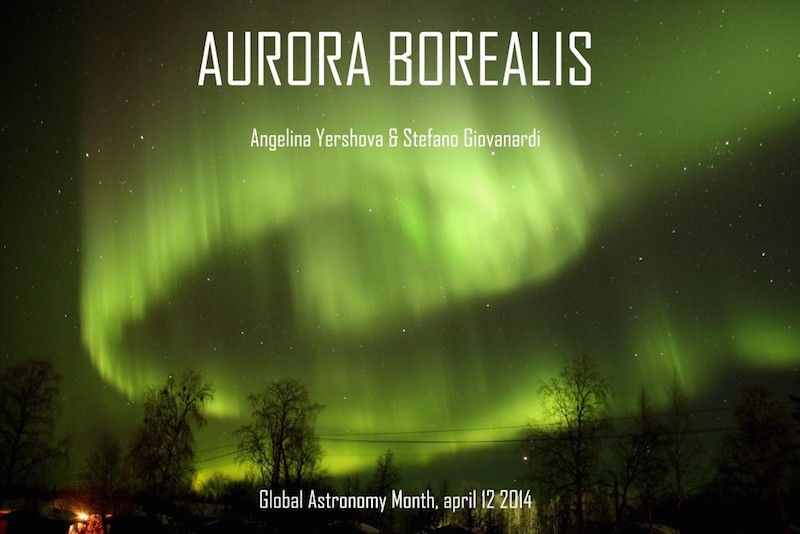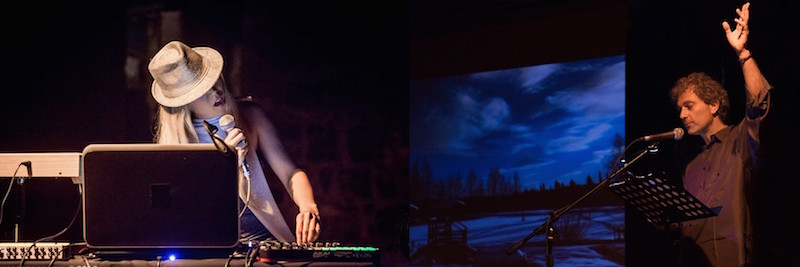by Stefano Giovanardi and Angelina Yershova
- Published: Wednesday, May 24 2017 22:08
 Here we are, for the second installment as Astro Artists of the month: let’s pick up the story from where we left it in the previous post. After the “early works” from 2009 to 2011, the Astroconcert project evolved toward new stylistic nuances with two new productions, over the years 2013 and 2015. In this post we will talk about the first one, leaving the other for our next installment. Yet, both of them represent our attempt in defining different possibilities to obtain a fine tuning between music and narration: in fact, Angelina Yershova introduced new variations in her musical research, using instruments such as the Theremin but also her voice and the classical piano, and exploring their fusion to “paint in sounds” original electronic and electro-acoustic soundscapes. On the other hand, Stefano Giovanardi gave a richer texture to his narration, researching ways to combine the attitude of science communication with the desire to convey his personal vision and fascination for the sky. In short, these more recent works express our progressive personalization of the project and show how the Astroconcert formula can be manipulated and diversified at will, in order to reach different targets and audiences: the Astroconcert project can support a personal and poetic science story, or it can delve into a more detailed scientific level, or it can push music in the front line.
Here we are, for the second installment as Astro Artists of the month: let’s pick up the story from where we left it in the previous post. After the “early works” from 2009 to 2011, the Astroconcert project evolved toward new stylistic nuances with two new productions, over the years 2013 and 2015. In this post we will talk about the first one, leaving the other for our next installment. Yet, both of them represent our attempt in defining different possibilities to obtain a fine tuning between music and narration: in fact, Angelina Yershova introduced new variations in her musical research, using instruments such as the Theremin but also her voice and the classical piano, and exploring their fusion to “paint in sounds” original electronic and electro-acoustic soundscapes. On the other hand, Stefano Giovanardi gave a richer texture to his narration, researching ways to combine the attitude of science communication with the desire to convey his personal vision and fascination for the sky. In short, these more recent works express our progressive personalization of the project and show how the Astroconcert formula can be manipulated and diversified at will, in order to reach different targets and audiences: the Astroconcert project can support a personal and poetic science story, or it can delve into a more detailed scientific level, or it can push music in the front line.

Angelina and Stefano after a performance in Cerveteri, 2015, photographed by Fabrizio Caratelli.
The opportunity to create a new Astroconcert came when Stefano took a memorable trip to Lapland, in March 2013, to observe and photograph the Northern Lights. It had been his dream for at least ten years, going up North to see with his own eyes the Aurora Borealis, and when it finally came true, he did his best to capture every moment of that journey – certainly one of the most exotic of his life. Stefano came back from Ivalo (Finland) with a full set of photographs and time lapse sequences of the Northern Lights, taken over a span of five nights (he was lucky enough that only one was clouded out). The sights of the Aurora left him with such a strong impression, that remains rooted in his heart and mind as “one of the three most beautiful sights I ever saw in the sky”. Since the photos were so beautiful and the story of that trip was fascinating, we decided to “brew” it in the form of a new Astroconcert: “Aurora Borealis”.
 One of the most spectacular auroras photographed by Stefano in Lapland, on his 2013 tour, became the poster for Aurora Borealis.
One of the most spectacular auroras photographed by Stefano in Lapland, on his 2013 tour, became the poster for Aurora Borealis.
Compared to Stellar Vibrations and Destination Infinity, Aurora Borealis takes a completely different approach and builds an entirely new relationship with the audience: it does not treat astronomical images and stars mainly as dreamful visions detached from our daily life, in order to mesmerize the public with astonishing visual effects and inspiring atmospheres, but it brings a real story into the sky, and shows how much mystery and fascination can be found in nature and in reality. This is a travel story, as well as a science story: the narration of a wonderful natural phenomenon (the science of the northern lights) flowing together with the diary of a trip that the speaker did in person up to Lapland, to see it. In fact, this combination could only be achieved by a more relevant and personal use of the narrator’s voice. As a consequence, also the narrative style uses two different vocal styles: one for reporting about the physics of the Northern Lights, as a eye witness or even as an explorer; another for sharing his memories and impressions from being there in first person, quite like reading his travel diary to the audience. Thus the narrator literally speaks with two voices – as if he were playing two different vocal instruments: a “documentaristic” voice and a more personal and intimate one. This research on the qualities of the narration helped drawing an emotional path throughout the entire concert, building up over the seven chapters of Aurora Borealis, from a dreamful introduction to a more concrete engagement with the flight to Lapland, through a detailed description of the physical connection between the Sun and the Earth that is the engine producing the northern lights, leading toward a personal enjoyment of the cosmic beauty of the lights dancing before your eyes. That is, without forgetting how cold it was, up north: under the sky of Lapland, Stefano experienced the lowest temperature of his whole life, a shivering -29°C!

All photographs by Marco Bellucci and Roberto Scorta
All around this emotional backbone, the music of Aurora Borealis was composed by Angelina to emphasize the flow of feelings and create a dialogue with the narrator voice, by driving the attention of the listener to focus alternatively on the scientific reality of the phenomenon or the personal participation to its display. In her performance, she not only sings and plays the grand piano, but uses extensively different electronic and electro-acoustic sonorities. Angelina creates mysterious textures and hybrid sound drones interlaced with the visual and narrative setup. Their intersections are designed to re-define the reality of the experience, giving an original dimension to the interplay between sounds-words-images and emotion, that is largely based on live improvisation as the sound is built upon Stefano’s voice and tone. This accurate synthesis between all the elements of the show becomes the most convincing basis upon which the listener is led to enjoy Stefano’s storytelling as if experiencing the Northern Lights in first person.

If a comparison can be made between Aurora Borealis and one of our earlier Astroconcerts, it certainly is with “Cosmic Echoes”, where a narrative structure based on multiple chapters first was introduced. However in Aurora Borealis the dialogue between music and words is pushed to a deeper level, as for the entire duration of the concert the interaction between voice and sound is constantly playing around their balance, shifting frequently toward opposite extremes – solo music or solo narration – but always seeking the most appropriate equalization, according to the general atmosphere of each chapter.

One important consequence of this careful approach to the mixing of music and words is the creation of several synesthetic games, i.e. resonances between certain sounds and certain words or intonations, between certain frequencies and rhythms and the pace of the speech, or even with the visual animations being projected.
The following video is a short compilation of excerpts from the performance of Aurora Borealis at the Planetarium of Rome, now closed.
Aurora Borealis is – so far – the most travelled of our productions: it premiered in the Summer of 2013 at the International Festival “Voci della Montagna” in Pescasseroli, a town in the mountains of Central Italy, and was sold out for its two dates at the Planetarium of Rome, where it was presented in the Astrosummer 2013 program. We were invited to perform Aurora Borealis also in Naples (International Festival of Electronic Literature, 2014) and Cerveteri, near Rome, at a Summer event called “A Testa in Sù – le Stelle e lo Spazio” organized by the Italian Space Agency (ASI) in 2016. When Astronomers Without Borders invited us to perform Aurora Borealis for the Global Astronomy Month 2014 we had the invaluable opportunity to bring an Astroconcert to a international audience around the world. That was also our first performance in English.
Here you can listen to the complete performance of Aurora Borealis, recorded for the Global Astronomy Month 2014 (duration 47 minutes):
If you are interested in knowing more about our project please email us at [email protected] or check our website www.astroconcert.com and follow us facebook and twitter. Samples taken from our performances are published on our YouTube channel Astroconcert.
In our next installment we’ll talk about the most recent of our productions, the Astroconcert “Icy Rose 67P”: we’ll be back next week!








Comments